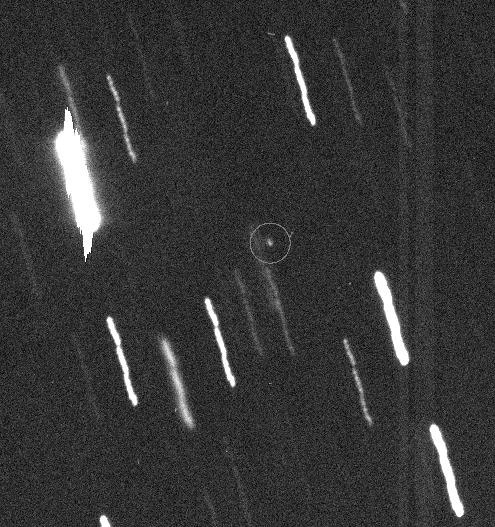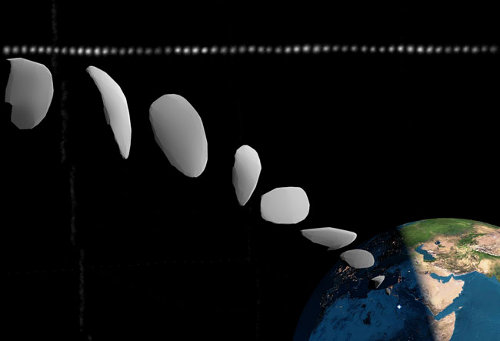New observations of asteroid Apophis, reported at the Division for Planetary Sciences meeting in Puerto Rico, indicate that the chances of its striking the Earth in 2036 must be recalculated, diminishing from roughly 1 in 45,000 to 1 in 250,000. There goes one disaster scenario, but enter another: An impact possibility exists for the year 2068. Says David Tholen (University of Hawaii):
“Our new orbit solution shows that Apophis will miss Earth’s surface in 2036 by a scant 20,270 miles, give or take 125 miles. That’s slightly closer to Earth than most of our communications and weather satellites.”
Too close for comfort, but a miss is a miss. Apophis reappears from behind the Sun in 2010 and is sure to be the object of even more intense scrutiny in years to come. But bear in mind that, just as we were able to refine our figures for the 2029 and 2036 encounters, we will probably be able to reduce the 1 in 333,000 chance now calculated for Apophis to actually strike in 2068.

Image: Asteroid Apophis will keep us occupied for some time in figuring out the chances it will strike the Earth at some future date. Perhaps more important, it serves as a reminder of the number of near-Earth objects we have yet to identify. Most of the data for the latest Apophis updates come from the University of Hawaii’s Institute for Astronomy in Manoa. Credit: UH/IA.
Remember that we’ve only known about this object since its 2004 discovery, and the subsequent finding that an impact probability (for April 13, 2029) existed caused a bit of a sensation before it was discounted. Now we’ve shoved Apophis back to 2068, but it continues to remind us that our catalog of Earth-crossing objects is anything but complete. Don Yeomans (JPL) notes that the Near-Earth Object Program Office at JPL offers a Twitter feed (@AsteroidWatch), or you can check the AsteroidWatch Web site.
Related: Also from the Division of Planetary Sciences meeting comes further word about the small asteroid 2008 TC3 that fell to Earth last year. This was the first asteroid to have been studied before it hit the Earth. Astronomers Marek Kozubal and Ron Dantowitz of the Clay Center Observatory (Brookline, MA) tracked the object for two hours just before impact. Peter Scheirich (Ondrejov Observatory, Czech Republic) and colleagues deduced that it was shaped like ‘a loaf of walnut raisin-bread.’

Image: Artist’s conception of 2008 TC3 approaching the Earth. Credit: SETI Institute.
I do a lot of baking and my walnut-raisin bread isn’t shaped much different from my standard sandwich loaf, so I’m uncertain about the detail here. But it’s fascinating to learn from forensic evidence presented at the DPS session that fragments of 2008 TC3 are of a type called ‘polymict ureilite.’ The meteorites show traces of being heated to 1150-1300 degrees Celsius before cooling rapidly, a process in which carbon in the asteroid turned part of its olivine mineral iron into metallic iron. A SETI Institute news release explains the significance of this:
… asteroid 2008 TC3 is the remains of a minor planet that endured massive collisions billions of years ago, melting some of the minerals, but not all, before a final collision shattered the planet into asteroids.
The news release, by the way, is written by Peter Jenniskens, who traveled to the impact site in the Sudan to study the asteroid and retrieved numerous fragments. And this is interesting: Despite the torturous impacts — the carbon in these meteorites is the most ‘cooked’ of all known meteorites, and carbon crystals of graphite and nano-diamonds have been detected — some of the original organic material survived. Polycyclic aromatic hydrocarbons have turned up in abundance, and Michael Callahan and colleagues (NASA GSFC) reported that they even found traces of surviving amino acids.



It’s remarkable that we can project an asteroid’s trajectory to such precision over a period of decades given how many hundreds of millions of miles the rock has to travel before it gets here.
Another thing that’s remarkable is the fact that we’re going to all but eradicate the existential threat from impacting asteroids within a few decades of finding out how much of a threat they can be. We’re not there yet, but with every passing year we are identifying more and more of the dangerous rocks out there and I have every confidence that within a couple of decades (if not before) no asteroid is going to be able to sneak up on us and cause global or even regional devastation.
We’ll still be vulnerable to collisions from comets making their first trip into the inner solar system for a while longer, given the short time we would have to meet such a threat, but the odds of something like that happening are far slimmer than being clobbered by an NEO, so there’s little to worry about.
In the long run, I’m far more concerned about what could happen below our feet. Underwater landslides (Hawaii, the Canaries) and caldera volcanoes (Yellowstone) are a far more difficult threat to deal with (if we ever can) and could cause massive hemisphere-wide devastation that would dwarf the destruction the Boxing Day Tsunami caused.
all of the above does indeed show at least to my mind our huge present capabilites! i imagine that they will only grow as the years and decades pass until finally we will have to worry less about such a strike.because we will be able to do something about it.or so i hope.maybe we “just” need alot more basic science.which by the way as an aside to all of us here,ought to be also a great help to the propulsion we all need and want to see in order to among other things fly to the stars! in that very vein…it would be “nice” if the LHC goes back on line sometime soon.thank you all,your friend george
“Peter Scheirich (Ondrejov Observatory, Czech Republic) and colleagues deduced that it was shaped like ‘a loaf of walnut raisin-bread.’”
So can we call 2008 TC3 manna from heaven? :^)
and on another similar and related topic. saw the last 15 minutes of an old movie today which i think was titled asteroid. sean connery of “007” fame was in it.they pool the nuclear missiles of the u s a and the then ussr in order to…i think vaporize a really humongous asteroid that is headed for earth.i say vaporize because,(and maybe this was indeed a grade c- sf movie) after the explosions nothing was left! then they say during the credits that in 1969 this very matter was studied by mit in a certain project icarus of theirs.got me over to the mit website where i found a place where they would accept general questions. took a chance after introducing myself to ask under i hope what was the correct topic if they could give me any hint about what is thought today on the subject of advanced propulsion for spacecraft.will await an answer but as we all may know by now usually 19 out of 20 such queries go unanswered! well if i do get an answer i will share it! thank you your friend george ps went so far as to say it would be fine if they simply had the title of a good book to recommend!!!! lol!!!! i might get back the title of the book tau zero just published! would that be ironic or not! the best as always your wordy friend george
George, that old movie came out thirty years ago this year and was
titled Meteor. An Irwin Allen disaster flick (in several senses of the
word) that was popular in the 1970s. Meteor probably did wake up
a few people back then about the possible threat from large space
bodies striking Earth (this was just before scientists starting finding
evidence that indicated the dinosaurs may have been wiped out by
a large space rock or comet 65 million years ago).
Meteor also had a manned spaceship that looked a lot like Skylab
named Challenger 2. Sadly it met an untimely end when NASA sent
it out to investigate a large asteroid that just happened to get hit by
a comet as the spacecraft arrived.
As for MIT’s Project Icarus, you may find these Web sites to be of use:
http://beyondapollo.blogspot.com/2009/09/project-icarus-1967.html
http://www.thespacereview.com/article/175/1
ljk,thanks those web sites where indeed interesting to see and yes that old movie may indeed have had some educational value. as for that e mail i sent mit,as of this minute it looks like it is in the 19 out of 20 category i had mentioned above.i keep trying such things because occcasionally to my delight i do get an answer! but anyhow thank you for your answer and have a great day.your friend george
Regarding Apophis, I read that there’s an extremely slim chance that, in its approach of April, 2029, the asteroid could pass through a gravitational “keyhole”, which would result in a greater probability of impact in April, 2036. Is this still possible?
Daniel, to the best of my knowledge, there remains a small chance that the ‘keyhole’ effect you’re talking about could raise the probability of impact. I don’t know what the current thinking on the odds of this are, though.